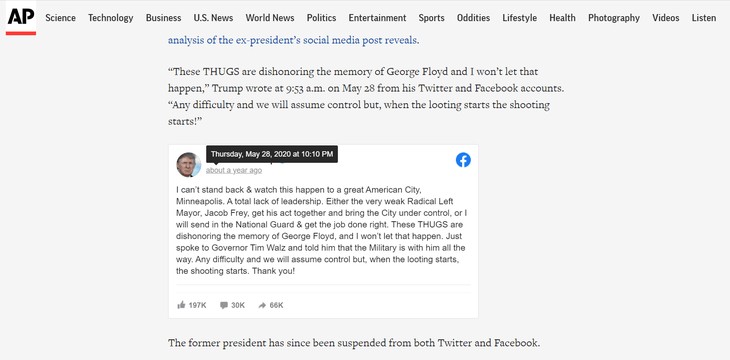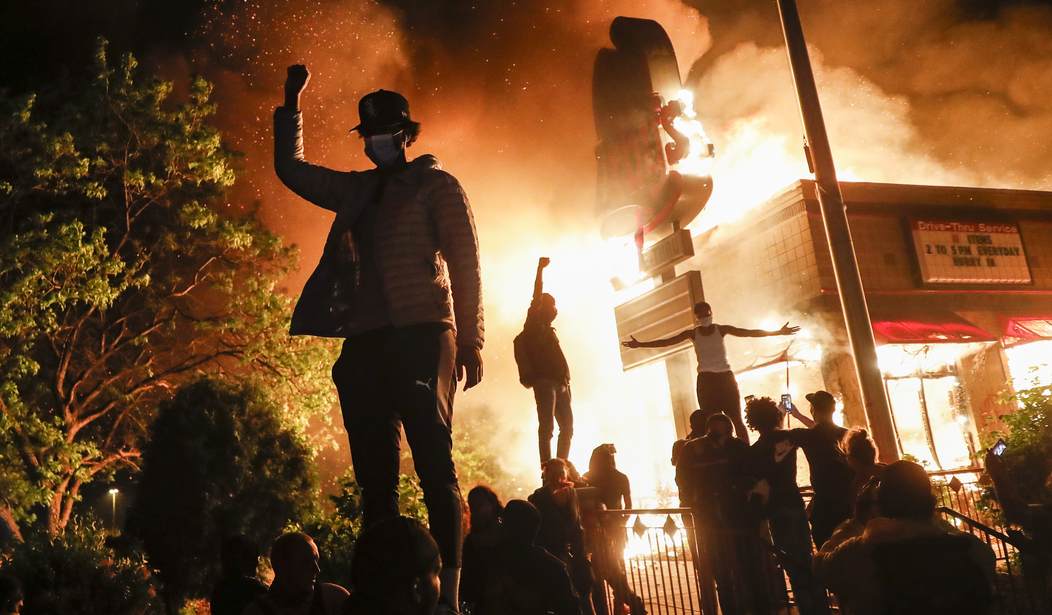Amanda Seitz is an Associated Press reporter. According to her Twitter profile, her assigned beat for AP is “disinfo.” On LinkedIn, she’s listed as an AP fact-checker. I want to avoid spreading disinformation or getting facts wrong, but I will assume “disinfo” is shorthand for disinformation. And “fact-checker” means she checks facts.
After reading her latest supposedly fact-based article for AP, I have some thoughts on the matter.
Her October 27th article is titled: America ‘on fire’: Facebook watched as Trump ignited hate.
I might be a bit pollyannaish, but I assumed I’d read a factual report on what Trump did or said that ignited the fire(s) which consumed America last year. Not so much.
Seitz began:
“The reports of hateful and violent posts on Facebook started pouring in on the night of May 28 last year, soon after then-President Donald Trump sent a warning on social media that looters in Minneapolis would be shot.”
She went on.
But it wasn’t until after Trump posted about Floyd’s death that the reports of violence and hate speech increased “rapidly” on Facebook across the country, an internal company analysis of the ex-president’s social media post reveals.
“These THUGS are dishonoring the memory of George Floyd and I won’t let that happen,” Trump wrote at 9:53 a.m. on May 28 from his Twitter and Facebook accounts. “Any difficulty and we will assume control but, when the looting starts the shooting starts!”
But according to The New York Times, Yahoo News, and Variety, and any other source you care to check, Trump posted his comment on May 29, not the morning of May 28. Additionally, according to the primary source — Facebook itself –, Trump’s post was made at 1:10 a.m. Eastern on May 29. That time is revealed by hovering over the “about a year ago” time frame that’s given on Trump’s Facebook post, which is embedded in — wait for it — Seitz’s AP article. (As I live in the Pacific time zone, the time given when hovering over the post is in Pacific time.)

The timeline is important. It should have been important to the AP “fact-checker.”
Floyd died on May 25. By the next day, demonstrations were growing exponentially and grew each day that followed. Protests were swelling throughout the country the day after. By May 27, looting was rampant in Minneapolis. In St Louis, a man died as people set fires and tried to loot a FedEx truck, all linked to Floyd’s death. In Los Angeles, roads were being blocked and looting had started in cities from coast to coast.
On May 28, the Third Precinct of the Minneapolis Police Department was burned to the ground.
Minnesota’s governor activated the National Guard, saying:
“The situation in Minneapolis, is no longer, in any way, about the murder of George Floyd. It is about attacking civil society, instilling fear, and disrupting our great cities.”
Cities across the country were already on fire.
But Trump had yet to write his “looting and shooting” post. On the morning of May 29, Trump posted it. He was roundly criticized for writing “when the looting starts the shooting starts.” Later the same day, he clarified what he meant and wrote:
“looting leads to shooting,” and the warning was meant as a “fact, not as a statement.”
“Looting leads to shooting, and that’s why a man was shot and killed in Minneapolis on Wednesday night – or look at what just happened in Louisville with 7 people shot. I don’t want this to happen, and that’s what the expression put out last night means….
— Donald J. Trump (@realDonaldTrump) May 29, 2020
(Trump tweeted after midnight on the east coast – May 29)
Seitz insistence that Trump had posted to Facebook (and incited violence) on May 28 is further illustrated with the following sentence:
“Offline, the next day, protests — some of which turned violent — engulfed nearly every U.S. city, big and small.”
That sentence includes a link to an AP article posted on May 29th. That linked article never mentions Trump’s social media posts, because he (or staff) had yet (or just posted) to Facebook. He had only tweeted in the early hours of May 29. His Facebook post followed his tweet, arguably done as a follow-up by staff. Further, the sentence clearly points a finger and infers blame on Trump’s Facebook post. It speaks to actual violence occurring after 9:53 on May 28. But Trump had yet to post. Seitz can’t cite evidence of Trump supporters violently taking to the streets on May 28, because he had yet to post to Facebook.
Even if Seitz didn’t “mean” just May 28 and was linking all subsequent violence to Trump’s Facebook post, a reasonable reader could assume that Trump’s post caused actual physical violence and/or property damage — yet Seitz offers no evidence it did. Why? Likely because in the 15 months since Trump’s Facebook post (and his later correction), there is no evidence proffered by Seitz to support her conclusion. Did Trump incite or cause a cadre of Trump supporters to storm the streets? Seitz infers it. Perhaps Seitz will write a follow-up article with facts, citing actual criminal cases or arrests of Trump supporters or, perhaps photos of rioters wearing MAGA hats, or maybe Trump flag-wavers filling the streets in response to protestors-turned-rioters? Her October 27 article offers none of that.
Perhaps her evidence is anecdotal, or made-up out of whole cloth, like Jacob Frey, the Mayor of Minneapolis. On May 30, Frey saw Trump’s May 29 social media posts as a pretext to blame someone, anyone, for the riots, so long as they were connected to George Floyd. He labeled rioters burning his city as white supremacists. While bunkered far away from his flaming city center, one precinct burned to the ground by Floyd rioters, he threw blame at “white supremacists,” tweeting:
“We are now confronting white supremacists, members of organized crime, out-of-state instigators, and possibly even foreign actors to destroy and destabilize our city and our region,”
Since tweeting that on May 30, 2020, Frey has offered no evidence that what he claimed was in fact, true. He still hasn’t. The rioting in his city continued. It continued throughout the country and spread to countries around the globe. None of the riots or billions of dollars in damage were ever linked to Trump’s Facebook post. Not then, not now.
Seitz’s thesis is clear. Trump’s Facebook posts caused violence.
Twice she hyperlinked an apparent source for the “Facebook” papers. They weren’t. The hyperlink here takes the reader to a collection of articles. The only article that discusses Trump is her own. She hyperlinked herself. And there is no link to the Facebook documents, and no cited evidence connecting Trump to the violence seen last summer.
Her “evidence” is an opinion of Lanier Holt, a professor of communications at Ohio State. Holt said:
“When people look back at the role Facebook played, they won’t say Facebook caused it, but Facebook was certainly the megaphone,” said Lanier Holt, a communications professor at Ohio State University. “I don’t think there’s any way they can get out of saying that they exacerbated the situation.”
In 2019 Holt told Michigan State students at the School of Communication Arts and Sciences:
“Very little of what we know about the world today comes from reality.”
Excluding Lanier Holt’s opinion, her article lacks any citable evidence Trump’s Facebook post did any more than foment angry Facebook posts. Based on Seitz’s tortured logic one could conclude that her article gave everyone a headache because it gave me one.
AP should fact-check their fact-checkers.














Join the conversation as a VIP Member